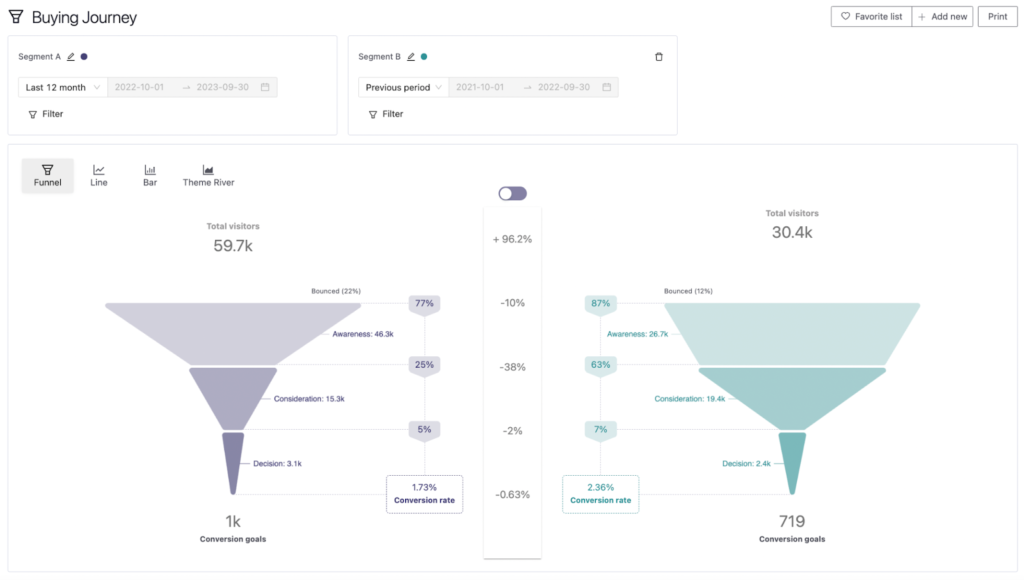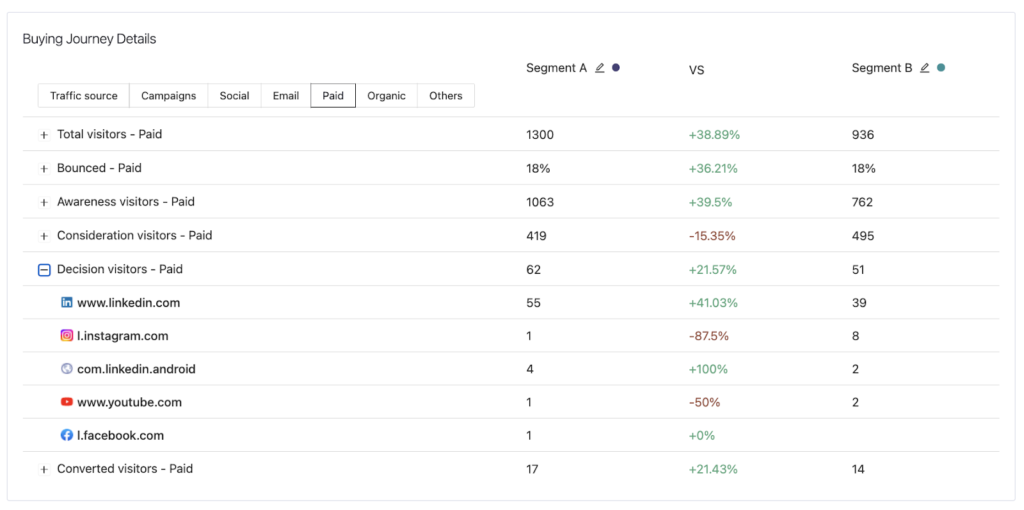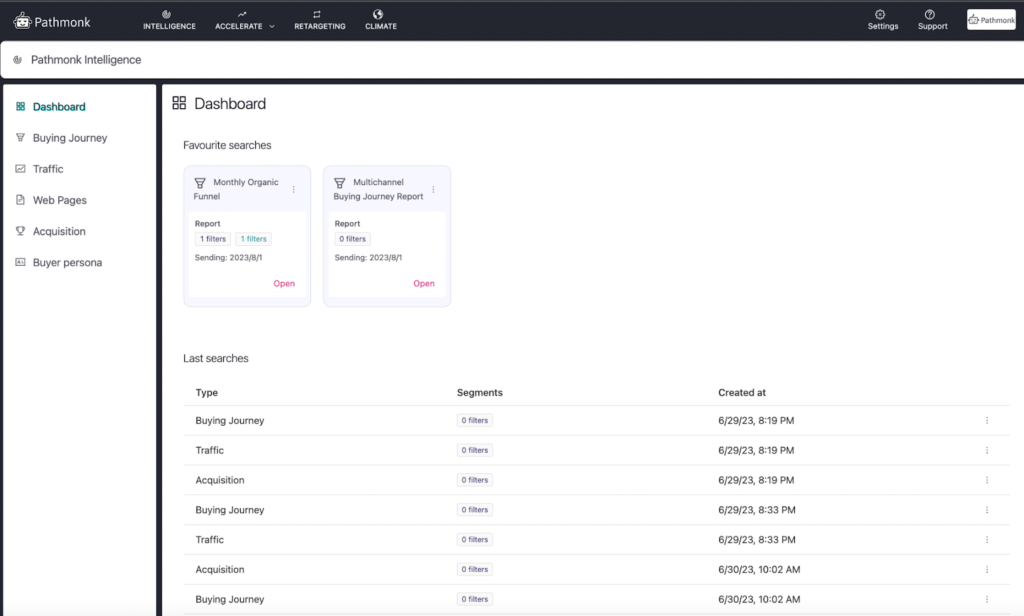Understanding the complex web of channels that contribute to your website’s conversions is crucial for success. As marketers, we are well aware of the challenges posed by multi-channel funnels. Tracking the journey of a potential customer across various touchpoints and discerning which channels played a pivotal role in the final conversion can often feel like solving a complex puzzle.
The ability to decipher these multi-channel funnels can be the key to optimizing your marketing efforts, allocating budgets wisely, and ultimately achieving your business goals. However, the process of analyzing multi-channel funnels has been a formidable challenge for marketers—until now.
In this comprehensive guide, we’ll introduce you to an innovative solution that will revolutionize your approach to multi-channel funnel analysis: Pathmonk Intelligence. Whether you’re a seasoned marketer or just starting your journey, this step-by-step tutorial will empower you to uncover the hidden insights within your multi-channel funnels, helping you make informed decisions and drive meaningful results.
Step by Step: Analyzing Multi-Channel Funnels with Pathmonk Intelligence
Pathmonk Intelligence provides a powerful set of tools for understanding how different channels contribute to your website’s conversions through multi-channel funnel analysis. While other tools require checking different analytics reports, such as channel acquisition, top paths to conversion, and multi-channel reports, Pathmonk Intelligence allows you to quickly analyze your funnel by following these simple steps:
After logging into your Pathmonk Intelligence account at https://crm.pathmonk.com/login, navigate to the Buying Journey report in the left-hand menu. Select the dates you want to analyze and, if needed, create a different time segment to compare.

The overview provides a high-level summary of your sales funnel, showing you exactly how your users behave across the decision-making process.
As you navigate to the Buying Journey details section, you can fine-tune your view of the customer journey by channel, enabling a comprehensive understanding of their impact on every stage of the funnel, including conversions.

The provided example above illustrates how distinct social advertising platforms, housed within the Paid channel, have played pivotal roles in advancing the decision stage. This information equips you with the insights needed to determine which of these platforms is most effective at driving conversions.
You will be able to know exactly how and when each channel and source is influencing your users to convert, without worrying about complicated and ever-changing attribution models. And it only took you 3 clicks.

You can also create and export your multi-channel funnel reports to share with your team or for further analysis and access them directly from your dashboard.
Remember to use the data to inform your marketing strategy and optimize channel allocation.
By following these steps, you’ll gain valuable insights into how different channels contribute to your website’s conversions, helping you make data-driven decisions to improve your marketing efforts.
Understand your customer journey analytics
See how your users behave, find drop-offs, and receive actionable insights with AI.

What are Multi-Channel Funnels?
Multi-channel funnels, often abbreviated as MCFs, are a crucial aspect of digital marketing analytics. They provide a comprehensive view of the various touchpoints and interactions that lead users to convert on your website. Essentially, multi-channel funnels reveal the entire customer journey leading to a conversion, which typically involves multiple marketing channels and interactions.
In a multi-channel funnel, each interaction a user has with your website is recorded, whether it’s a click from a paid ad, an organic search, a social media visit, or any other channel. These interactions are organized in a sequence, showing how users navigate through different touchpoints before completing a conversion goal, such as making a purchase, signing up for a newsletter, or filling out a contact form.
Why are Multi-Channel Funnels Essential for Conversion Analysis?
Multi-channel funnels are essential for conversion analysis for several reasons:
- Holistic View: They provide a holistic view of the customer journey, helping you understand that conversions rarely occur from a single interaction. Instead, they result from a series of touchpoints across various channels.
- Attribution: They offer insight into attribution, showing which channels and interactions contribute to conversions. This knowledge is critical for allocating marketing budgets effectively.
- Optimization: Multi-channel funnel analysis enables you to identify the most effective channels, assisting channels, and potential bottlenecks in the conversion path. This information empowers you to optimize marketing strategies.
- Complex Journeys: In today’s digital landscape, user journeys are often complex. Users may research, compare, and interact with your brand across different channels and devices before converting. MCFs help you make sense of these intricate paths.
- Data-Driven Decisions: By understanding how channels work together, you can make data-driven decisions. This leads to more efficient marketing spending and better user experiences.
Common Challenges Faced by Marketers
While multi-channel funnels offer valuable insights, marketers often face challenges when working with them:
- Data Integration: Gathering data from various marketing platforms and integrating it into your analytics tool can be complex and time-consuming.
- Attribution Models: Choosing the right attribution model is crucial. Marketers may struggle to decide which model best represents their customers’ conversion paths.
- Complexity: Multi-channel funnel reports can be overwhelming due to the wealth of information presented. Marketers need to learn how to extract actionable insights.
- Cross-Device Tracking: Tracking user journeys across multiple devices (e.g., from mobile to desktop) can be challenging but is essential for a complete view of the conversion path.
- Real-Time Analysis: Some marketers may find it difficult to keep up with real-time analysis of multi-channel funnels, especially in rapidly changing markets.
Pathmonk Intelligence: The Solution for Analyzing Multi-Channel Funnels
With a primary focus on multi-channel funnel analysis, Pathmonk Intelligence’s key features are tailored to empower marketers to make data-driven decisions and optimize marketing strategies with precision.
- Behavioral Analysis: Pathmonk employs machine learning to analyze user behavior data, identifying common sequences of actions that lead to conversions or abandonment. This helps you discover effective user pathways and areas that may need optimization, providing a deeper understanding of how channels contribute to your goals.
- Channel Contribution Insights: Pathmonk Intelligence allows you to identify the specific contributions of different marketing channels and interactions to your multi-channel funnels, helping you optimize your budget allocation and marketing strategies effectively.
- Cookieless Technology: Pathmonk Intelligence operates entirely without cookies, ensuring strict compliance with evolving privacy regulations. This sets it apart from traditional analytics platforms, making it a trusted choice for safeguarding user data and privacy.
- Real-Time Analysis: We excel in real-time data analysis. Pathmonk Intelligence continuously monitors and analyzes user interactions across various channels, ensuring that the data you receive is both timely and accurate. This real-time approach is invaluable for keeping up with dynamic user behaviors.
- AI-Driven Insights: At the heart of Pathmonk Intelligence are cutting-edge artificial intelligence algorithms. These algorithms process data from different marketing channels and distill it into actionable insights, simplifying decision-making and optimizing marketing strategies. The AI-driven insights enhance your ability to understand channel contributions and user journeys in detail.
- Precision in Attribution Modeling: Accurate attribution modeling is pivotal for assessing the performance of marketing channels and campaigns. Pathmonk Intelligence’s AI-powered algorithm excels in providing precise attribution data for effective marketing optimization, ensuring your budget allocation is well-informed.
- Centralized Data Hub: Pathmonk Intelligence serves as a single source of truth for data collection and analysis, streamlining the process of comprehending user behavior, channel interactions, and conversion paths. This centralized hub simplifies the often complex task of multi-channel funnel analysis.
How to Add Pathmonk Intelligence to Your Marketing Strategy
Step 1: Free Demo and Sign-Up
If you want a hands-on test of how Pathmonk Intelligence works and what it can do for you, sign up for a Free Demo. This hands-on experience will provide you with valuable insights into how Pathmonk Intelligence can work to your advantage.
Alternatively, you can directly start your journey with Pathmonk Intelligence by signing up for an account. Simply select Pathmonk Intelligence and the amount of monthly pageviews our engine will have to process.
Step 2: Onboarding and Installation
Once registered, the next step is to integrate Pathmonk Intelligence with your platform.
The onboarding process has been designed to be exceptionally user-friendly, making it a self-service experience that ensures you’re up and running smoothly.
Step 3: Data Configuration
Your business is one-of-a-kind, and so are your objectives. We encourage you to customize your data collection settings to precisely align with your unique business goals. This level of customization empowers you to tailor your goals, ensuring that you receive the most relevant insights that will truly impact your success.
You have the flexibility to establish your goals using various methods: through a URL, a pixel that doesn’t rely on cookies, or by integrating with a third-party application.
Applying Pathmonk Intelligence Multi-Channel Funnel Analysis to Your Marketing Strategy
Once armed with insights from Pathmonk Intelligence’s multi-channel funnel analysis, you have a powerful tool at your disposal. Here’s how you should leverage the derived outcomes:
- Optimizing Marketing Budgets and Strategies: Allocate your resources with precision. Pinpoint which channels and campaigns yield the highest returns, and adjust your budget allocation accordingly. Eliminate wasteful spending on underperforming channels and reallocate those resources to areas with proven conversion potential.
- Improving Channel-Specific Campaigns: Tailor your campaigns to suit the strengths and preferences of each channel. Leverage the insights to refine your messaging, creative assets, and targeting strategies. Maximize the impact of each channel by understanding how users interact within them, ultimately guiding them toward conversion.
- Making Data-Driven Decisions Based on the Analysis: Use the comprehensive data to inform your marketing decisions. Rely on concrete insights rather than gut feelings or assumptions. Identify trends, patterns, and areas for improvement, allowing you to fine-tune your strategies for maximum effectiveness.
- Tracking the Impact of Changes Over Time: Implement changes based on your insights and monitor their impact over time. This allows you to assess the effectiveness of your strategies and refine them as needed. Continuously track user behavior, conversions, and channel contributions to stay ahead of evolving trends and make timely adjustments.
Exploring Pathmonk Intelligence Multi-Channel Funnel Analysis Use Cases
Pathmonk Intelligence’s multi-channel funnel analysis is a versatile tool that finds valuable applications across various industries. Here’s a glimpse into how it can be applied in different sectors:
eCommerce
- Conversion Optimization: Understand the customer journey leading to purchases. Identify high-impact channels and touchpoints to refine product offerings, messaging, and user experience.
- Abandoned Cart Recovery: Analyze user behavior post-cart abandonment to implement targeted re-engagement strategies through the most effective channels.
SaaS and Software Companies:
- Free Trial to Paid Conversion: Track user interactions from free trials to paid subscriptions. Optimize messaging and nurture sequences to increase conversion rates.
- Feature Adoption: Analyze the paths users take to adopt specific features, allowing for more targeted onboarding and education.
B2B Services:
- Lead Generation and Nurturing: Gain insights into the channels and interactions that lead to successful lead conversions. Fine-tune lead generation campaigns for maximum impact.
- Sales Funnel Optimization: Understand the journey from initial interest to becoming a paying customer, refining strategies to shorten sales cycles.
Retail Stores:
- Online-to-Offline Conversions: Analyze the digital touchpoints that drive in-store visits and purchases. Optimize online marketing efforts for local customer acquisition.
- Customer Loyalty Programs: Track the impact of loyalty programs across different channels, allowing for adjustments to increase program effectiveness.
Hospitality and Tourism:
- Booking Funnel Optimization: Track the customer journey from initial interest to booking confirmation. Identify opportunities to streamline the booking process and enhance user experience.
- Personalized Recommendations: Understand user preferences for travel destinations and activities, enabling more tailored marketing and promotional efforts.





